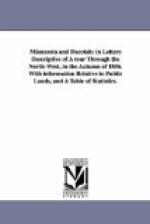St. Paul, October, 1856.
The progress which has characterized the settlement of the territory of Minnesota, presents to the notice of the student of history and political economy some important facts. The growth of a frontier community, so orderly, so rapid, and having so much of the conservative element in it, has rarely been instanced in the annals of the world. In less time than it takes the government to build a custom house we see an unsettled territory grown to the size of a respectable state, in wealth, in population, in power. A territory, too, which ten years ago seemed to be an incredible distance from the civilized portions of the country; and which was thought by most people to be in a latitude that would defeat the energy and the toil of man. Today it could bring into the field a larger army than Washington took command of at the beginning of our revolution!
In 1849, the year of its organization, the population of the territory was 4780; now it is estimated to be nearly 200,000. In 1852 there were 42 post offices in the territory, now there are 253. The number of acres of public land sold during the fiscal year ending 30th June, 1852, was 15,258. For the year ending 30th June, 1856, the number of acres sold was 1,002,130.
When we contemplate the headlong progress of Western growth in its innumerable evidences of energy, we admit the truth of what the Roman poet said— nil mortalibus ardum est— that there is nothing too difficult for man. In the narrative of his exploration to the Mississippi in 1820, along with General Cass, Mr. Schoolcraft tells us how Chicago then appeared. “We found,” says he, “four or five families living here.” Four or five families was the extent of the population of Chicago in 1820! In 1836 it had 4853 inhabitants. In 1855 its population was 85,000. The history of many western towns that have sprung up within ten years is characterized by much the same sort of thrift. Unless some terrible scourge shall come to desolate the land, or unless industry herself shall turn to sloth, a few more years will present the magnificent spectacle of the entire domain stretching from this frontier to the Pacific coast, transformed into a region of culture, “full of life and splendor and joy.”
At present there are no railroads in operation in Minnesota; but those which are already projected indicate, as well as any statistics, the progress which is taking place. The Chicago, St. Paul, and Fond-du-Lac Railroad was commenced some two years ago at Chicago, and over 100 miles of it are completed. It is to run via Hudson in Wisconsin, Stillwater, St. Paul, and St. Anthony in Minnesota to the western boundary of the territory. Recently it has united with the Milwaukee and La Cross Road, which secures several millions of acres of valuable land, donated by congress, and which will enable the stockholders to complete the road to St. Paul and St. Anthony within two years.




